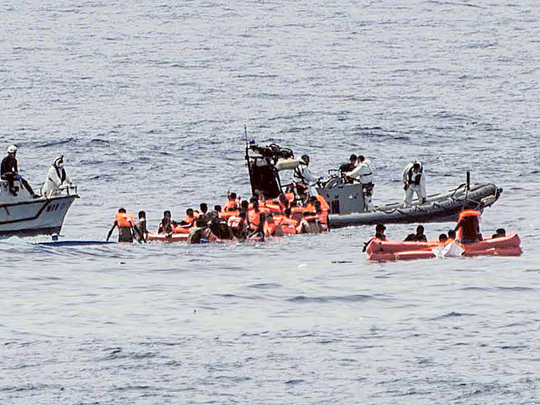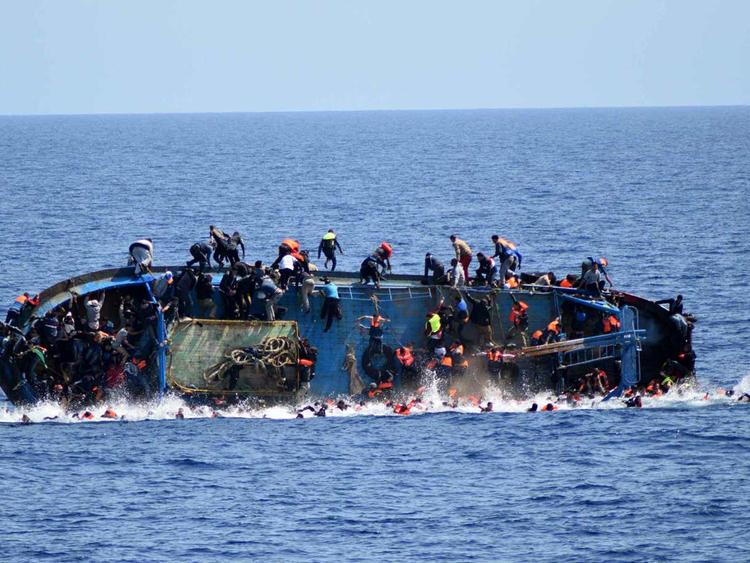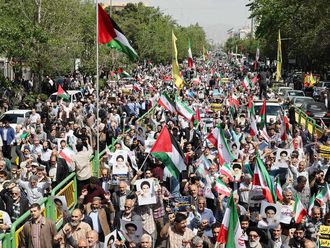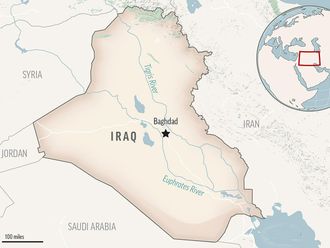
Dubai: The smuggling chain between North Africa and Europe has become more sophisticated in the past year, with criminal gangs and human traffickers now becoming better connected and more organised, analysts at the European border agency, Frontex, are warning.
“In recent years people smuggling networks have become better organised and interconnected. In some cases, the dangerous crossing from Sub-Saharan Africa into Europe would take months, or even years, with migrants being subjected to robbery, slavery, forced work, rape and torture,” the agency says. “Now the crossing of the land routes in Africa can take as little as a couple of weeks, but the risks to the safety of migrants remain extremely high.”
In the past week, vessels from an international flotilla of ships working on Frontex operations in the central Mediterranean plucked 13,000 people from boats. On Saturday, some 670 were rescued.
The rescues by the Italian coast guard and navy ships, aided by Irish and German vessels and humanitarian groups, are the latest by the multinational patrol south of the Italian island of Sicily.
The Irish military said the vessel Le Roisin saved 123 people from a 12-metre long rubber dinghy and recovered a man’s body, while a German ship was involved in four separate rescue operations, the Italian coast guard said on Saturday evening.
In 2015, the route from Libya to the European Union was mainly used by refugees from the Horn of Africa and Western African countries.
Last year, an estimated 870,000 refugees used the eastern Mediterranean route through Turkey to the Greek islands in the Aegean. According to Frontex, there are multiple smuggling networks and each controls a specific departure area.
“The criminal networks serving specific hubs in Izmir, Bodrum and Istanbul are very efficiently organised, analysts say. “They recruit the migrants and organise transportation to the departure points on the coast. The networks also tend to serve specific nationalities — Syrians, Afghans, Pakistanis or Bangladeshis.”
The smugglers also passed on information about the asylum processes in different EU member states and sell the refugees forged documents. The highest demand was for Syrian passports, identification cards, birth certificates and residence permits.
Many Syrians use social media to prepare for their trips and are well informed about the smuggling fees, allowing them to negotiate lower prices.
According to refugees’ testimonies, smugglers send refugees towards Greece despite difficult weather conditions, which leads to many tragedies at sea. Frontex has found evidence of discounts that were offered to those people willing to travel in bad weather. Rubber dinghies of about eight metres in length normally transport 40 to 60 refugees.
Last year, human smugglers profited to the tune of $5 billion (Dh18.6 billion) on the eastern Mediterranean route. Now, with the border crossing between Turkey and the European Union nations effectively closed off to refugees, the focus has shifted back to the treacherous sea crossing between Libya and southern Europe.
Frontex and other agencies estimate that there are an estimated 800,000 waiting in Libya ready to cross. With the weather better and the seas calmer, the floodgates are now beginning to open on the summer season — and Libya is the perfect staging point. The human smuggling operation is thriving because of the chaotic situation in Libya since the fall of Muammar Gaddafi and his regime.
“What is characteristic of the smuggling networks in Libya is the proliferation of actors, ranging from ordinary Libyan citizens offering their services to refugees, to former militiamen and law enforcement officers,” the Frontex analysts warn. “Due to the increasingly profitable business of smuggling migrants by sea, the crossing has become even more risky for the migrants as the networks start to compete with each other, which in turn affects the security of the refugees even more: refugees speak of cruel and aggressive smugglers forcing larger numbers of people onto the rubber boats, often at gunpoint, to squeeze more money from each trip.”
The agency says the smuggling operation is highly organised and likely involves a large number of people with experience in running large-scale operations.
“The journey across the African continent is a gruelling one that for many involves a dangerous desert crossing in an open truck speeding to avoid the authorities and criminals alike,” Frontex says. “It is impossible to calculate the number of people who do not survive this trip but it is likely very high. On this particular route, usually different smuggling groups tend to serve specific legs of the journey.”
What is clear is one route from Eritrea seems to be controlled by a single sophisticated network managing the whole journey, starting from Eritrea going through Sudan, and then into Libya. And the gang is benefitting from money moved through the traditional hawala network — an informal way of transferring funds based on honour code operating outside traditional financial channels. Hawala is mainly used in the Middle East, North Africa and the Horn of Africa and relies on a network of brokers.
But it’s not just Libyans and sub-Saharans who are using this route. Frontex warns some of those taking to the boats from Libya are refugee workers and contractors who had lived there in recent years — Bangladeshis who worked on oil and gas projects. “Fearing the increasing level of violence and seeing their living conditions dramatically deteriorating, many decide to make the dangerous journey to Italy, using the existing smuggling networks in Libya to cross the Mediterranean,” the agency cautions.
And with Libya in a virtually lawless state since the fall of Gaddafi, it’s a perfect storm for people smugglers to thrive.
“Libya was a destination country in its own right for workers from around the world. Many of these, still resident in Libya, have found new work as ‘recruiters,’ liaising between the Libyan-controlled criminal gangs and would-be migrants pouring in to the country,” Frontex says.
The tentacles of the gangs stretch deep into the Libyan interior. Frontex identified two principal overland routes to Tripoli. The eastern one, leading from Somalia, Ethiopia, Eritrea and Sudan towards Al Kufrah in the eastern Libyan Desert, is the most highly organised.
The western route, from Mali, Nigeria and Niger up to Tripoli via Qatrun and Sabha, is more informal with regular bus lines used by migrants to reach Agadex in Niger.
In both cases, however, the Libyan leg of the journey is jealously controlled by local militiamen, whose ranks have been swollen by former soldiers of the Gaddafi regime.
Smartphones are life savers
Online information has an immense effect on refugee smuggling. Social media is a popular tool used by smuggling networks to advertise their services and by refugees themselves to gather information about the journey ahead and to contact friends and relatives, Frontex says.
For many people fleeing war or persecution, their smartphone is one of their most precious belongings.
Facebook pages are usually run by middlemen and resemble travel agencies, with photos, information on the price and route as well as useful tips for the journey. They include ratings of trustworthy facilitators, best routes, countries to avoid, as well as a blacklist of smugglers.
What is very characteristic is that these pages appear quickly and disappear just as fast, making them difficult to track. They are mainly used by tech-savvy Syrians and are written in Arabic.
Facebook pages also offer fake documents for sale, advertising themselves as travel agencies usually based in Turkey.
The people who are advertising their services on social media are aware of the risks and operate on multiple social media platforms. Typically they use applications such as Facebook, WhatsApp and Viber to discuss financial details and logistics of the smuggling operation.













